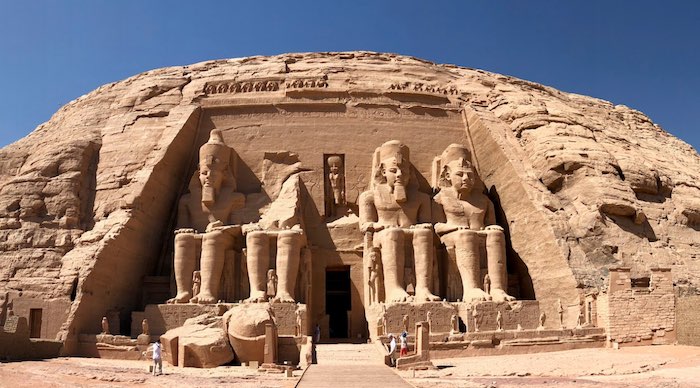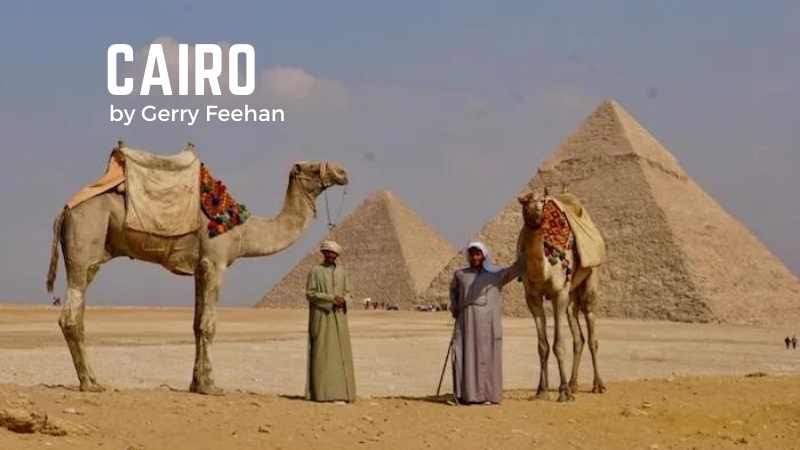Gerry Feehan
Gerry Feehan explores Cape Breton Island

The Cabot Trail makes for a beautifully colourful autumn drive.
The Canso Causeway connects mainland Nova Scotia to the island of Cape Breton. As we drove across the span on a crisp autumn day, the ebb tide was pulling westward, hard through the Canso Strait. We stopped at the Port Hastings visitor’s centre where a pleasant woman bid us welcome and told us we were in luck, “You’re just in time for the Celtic Colours.” Being an observant fellow, I had already noted the changing season—the brilliant oranges and reds of the Maritimes’ fall foliage. And I smartly told her so. “Oh, no,” she laughed, “Celtic Colours isn’t about the leaves. It’s our annual autumn festival.” For nine days every October the entire island hops with a chorus of Cape Breton traditions: ceilidhs, live music, spoken word and dance performances, all celebrating the island’s rich history and culture.
But before we did any festival going, it was exploration time. Cape Breton is a marvel of twisting vistas, glorious hikes, great food—and friendly people. En route to the world-renowned Cabot Trail in Cape Breton Highlands National Park we took a circuitous path, skirting Bras D’Or Lake (not really a lake, more a brackish inland sea). Along the lakeshore near Big Pond we stopped and paid homage to Rita McNeil at the late singer’s eponymous Tea Room. When we finally arrived at Ingonish Beach Campground on the National Park’s southeast border, it was late in the day. We ate dinner and hit the hay. There was a big hike planned for the morning: Franey Trail, a long steep climb to a panoramic viewpoint from which one looks down on the Clyburn River canyon spilling into the Atlantic Ocean. Admiring the view at the summit, we chatted quietly with a young local couple who were proud to tell us the history of the region, their Scottish heritage and the hard lives their ancestors had endured on land—and at sea, which they wistfully stared out as they shared the memory.
That evening we dined luxuriously at the historic Keltic Lodge and later, over a digestif in the leathery lounge, struck up conversation with a European tourist. “Don’t you think Cape Bretoners are the friendliest people on earth?” I asked. We had been overwhelmed by Maritime hospitality. Looking puzzled, he answered dryly, in a thick accent, “I have had only a few weeks here, so I am not yet able to arrive at this conclusion.” Tough sell, those Germans.
When we awoke the air was cool, crisp and clear—a perfect day for an autumn sojourn on the Cabot Trail, which loops for 298km around the northern tip of Cape Breton. We cruised counterclockwise from Ingonish. Our first stop was White Point where the harsh Atlantic batter stony cliffs along the island’s unprotected north shore. Then we began a twisting ascent through the lush Acadian forest to Cape Breton’s central highlands. The display of foliage was magical. Maple, beech and birch all boasted their brightest fall colours in hues of red, orange and yellow. And, as if frozen in the windless air, the trees had yet to drop a single leaf. It was a palette of autumn perfection.

I pulled the motorhome into a serene overlook. Florence and I sat in silence, gazing through the windshield at the crimson and gold majesty. Suddenly, and before I could exit the vehicle to snap a picture, three vanloads of tourists pulled in, sprung from their seats and began frantically taking photos. Abandoning the hope of any verdant solitude, I instead jumped into the cacophonous human fray and started taking shots of tourists taking pictures.

We set up camp that evening at quiet MacIntosh Brook near Lone Shieling, where 350 year-old sugar maple trees stand sentinel over a long-abandoned Scottish crofter’s hut. Despite the quiet, I didn’t sleep well that night, for there was a menacing giant lurking in my future: Cabot Cliffs Golf Links.
You may have read my charming story about golf in Ireland – and how the Irish courses were the most beautifully humiliating courses I had ever encountered. Well, Cape Breton Island has retained its Celtic tradition not only in music and dance but also in its fondness for brutal but alluring links golf. Cabot Cliffs is equal to the best of its turf cousins across the sea. I was fortunate to secure a tee time—and a private caddy—to enjoy this spectacular course.

Another ball prepares to meet the briny Atlantic.
After the (humbling) golf interlude, we re-dedicated ourselves to exploration by foot with a last hike, on the Skyline Trail on Cape Breton’s west coast. Although crowded, the traipse was enjoyable and the ocean views breathtaking. On a clear day (which we experienced) one can see the white cliffs of Quebec’s Magdalen Islands shining distantly in the Gulf of St Lawrence.
With tired feet—and badly in need of food and drink—we arrived late at Cheticamp Campground. I noticed a sign announcing that the Harbour Restaurant in this quaint Acadian village offered a free shuttle for patrons. I phoned, booked a reservation and requested a ride. 15 minutes later a car pulled up to our campsite and a pleasant lady with a French-Canadian accent said, “Hop in.” It was Lorraine LeBlanc, the restaurant owner. And after a great chow down on Morue en Cabane (slow-cooked cod, chives and pork scraps) and Lorraine’s famous Apple Garden cake, she returned us to our campsite. Now that’s Cape Breton hospitality! Despite my inherent thriftiness, I left a reasonable tip.
Our time in the Highlands was coming to an end and still there was the Celtic Colours to enjoy. The festival venues are island-wide but many artists bunk each night at the Gaelic College in St Ann’s near Baddeck (Alexander Graham Bell’s summer stomping grounds). Widely scattered venues result in a long, dark drive on narrow roads back to St Ann’s after a day of performing. But for the tireless musicians the party carries on—with impromptu jam sessions lasting well into the wee hours.We arrived in St Ann’s on the last night of the Festival. We boon-docked in the Gaelic College parking lot. The Celtic Colours finale was scheduled to begin very late, past 12:00am—and well past our bedtime—so, after a parking lot BBQ, we lay down for a disco nap, awaking after midnight to the sound of instruments being tuned. It was a raucous evening, hosted by the effervescent humour of singer-songwriter Buddy MacDonald. It was past 4 am when the last fiddle was packed unwillingly into its case. We trundled off to bed… and enjoyed a well-deserved Celtic sleep in.

Gerry Feehan is an award-winning travel writer and photographer. He lives in Kimberley, BC.

Thanks to Kennedy Wealth Management for sponsoring this series. Click on the ads and learn more about this long-term local business.
Gerry Feehan
Abu Simbel

Abu Simbel is a marvel of ancient and modern engineering
I love looking out the window of an airplane at the earth far below, seeing where coast meets water or observing the eroded remains of some ancient formation in the changing light. Alas, the grimy desert sand hadn’t been cleaned from the windows of our EgyptAir jet, so we couldn’t see a thing as we flew over Lake Nasser en route to Abu Simbel. I was hopeful that this lack of attention to detail would not extend to other minor maintenance items, such as ensuring the cabin was pressurized or the fuel tank full.
We had just spent a week on a dahabiya sailboat cruising the Nile River, and after disembarking at Aswan, were headed further south to see one of Egypt’s great
monuments. There are a couple of ways to get to Abu Simbel from Aswan. You can ride a bus for 4 hours through the scorched Sahara Desert, or you can take a plane for the short 45-minute flight.
Opaque windows notwithstanding, I was glad we had chosen travel by air. Abu Simbel is spectacular, but there’s really not much to see except the monument itself and a small adjacent museum. So most tourists, us included, make the return trip in a day. And fortunately we had Sayed Mansour, an Egyptologist, on board. Sayed was there to explain all and clear our pained expressions.
Although it was early November, the intense Nubian sun was almost directly overhead, so Sayed led us to a quiet, shady spot where he began our introduction to
Egyptian history. Abu Simbel is a marvel of engineering — both modern and ancient. The temples were constructed during the reign of Ramses II. Carved from solid rock in a sandstone cliff overlooking the mighty river, these massive twin temples stood sentinel at a menacing bend in the Nile — and served as an intimidating obstacle to would-be invaders — for over 3000 years. But eventually Abu Simbel fell into disuse and succumbed to the inevitable, unrelenting Sahara. The site was nearly swallowed by sand when it was “rediscovered” by European adventurers in the early 19 th century. After years of excavation and restoration, the monuments resumed their original glory.
Then, in the 1960’s, Egyptian president Abdel Nasser decided to construct a new “High Dam” at Aswan. Doing so would create the largest man-made lake in the
world, 5250 sq km of backed-up Nile River. This ambitious project would bring economic benefit to parched Egypt, control the unpredictable annual Nile flood and also supply hydroelectric power to a poor, under-developed country. With the dam, the lights would go on in most Egyptian villages for the first time. But there were also a couple of drawbacks, which were conveniently swept under the water carpet by the government. The new reservoir would displace the local Nubian population whose forbearers had farmed the fertile banks of the Nile River for millennia. And many of Egypt’s greatest monuments and tombs would be forever submerged beneath the deep new basin — Abu Simbel included. But the government proceeded with the dam, monuments be damned.
Only after the water began to rise did an international team of archaeologists, scientists — and an army of labourers — begin the process of preserving these
colossal wonders. In an urgent race against the rising tide, the temples of Abu Simbel were surgically sliced into gigantic pieces, transported up the bank to safety and reassembled. The process was remarkable, a feat of engineering genius. And today the twin edifices, honouring Ramses and his wife Nefertari remain, gigantic, imperious and intact. But instead of overlooking a daunting corner of the Nile, this UNESCO World Heritage site now stands guard over a vast shimmering lake.
Sayed led us into the courtyard from our shady refuge and pointed to the four giant Colossi that decorate the exterior façade of the main temple. These statues of
Ramses were sculpted directly from Nile bedrock and sat stonily observing the river for 33 centuries. It was brutally hot under the direct sun. I was grateful for the new hat I had just acquired from a gullible street merchant. Poor fellow didn’t know what hit him. He started out demanding $40, but after a prolonged and brilliant negotiating session, I closed the deal for a trifling $36. It was difficult to hold back a grin as I sauntered away sporting my new fedora — although the thing did fall apart a couple of days later.
Sayed walked us toward the sacred heart of the shrine and lowered his voice. Like all Egyptians, Sayed’s native tongue is Arabic. But, oddly, his otherwise perfect English betrayed a slight cockney accent. (Sayed later disclosed that he had spent a couple of years working in an East London parts factory.) He showed us how the great hypostyle hall of the temple’s interior is supported by eight enormous pillars honouring Osiris, god of the underworld.

Exploring the inner temple

Nefertari
Sayed then left us to our devices. There were no other tourists. We had this incredible place to ourselves. In the dim light, we scampered amongst the sculptures
and sarcophagi, wandering, hiding and giggling as we explored the interior and its side chambers. At the far end lay the “the holiest of holies” a room whose walls were adorned with ornate carvings honouring the great Pharaoh’s victories — and offering tribute to the gods that made Ramses’ triumphs possible.
Exterior photographs of Abu Simbel are permitted, but pictures from within the sanctuary are verboten — a rule strictly enforced by the vigilant temple guardians — unless you offer a little baksheesh… in which case you can snap away to your heart’s content. Palms suitably greased, the caretakers are happy to pose with you in front of a hidden hieroglyph or a forbidden frieze, notwithstanding the stern glare of Ramses looking down from above.

A little baksheesh is key to holding the key
After our brief few hours at Abu Simbel, we hopped back on the plane. The panes weren’t any clearer but, acknowledging that there really wasn’t much to see in the Sahara — and that dirty airplane windows are not really a bona fide safety concern — I took time on the short flight to relax and bone up on Ramses the Great, whose mummified body awaited us at the Egyptian Museum in Cairo.
Exodus Travel skilfully handled every detail of our Egypt adventure: www.exodustravels.com/
Gerry Feehan is an award-winning travel writer and photographer. He lives in Kimberley, BC.

Thanks to Kennedy Wealth Management for sponsoring this series. Click on the ads and learn more about this long-term local business.
Gerry Feehan
Cairo – Al-Qahirah

The Pyramids of Giza
The first thing one notices upon arrival in Egypt is the intense level of security. I was screened once, scanned twice and patted down thrice between the time we landed at the airport and when we finally stepped out into the muggy Cairo evening. At our hotel the scrutiny continued with one last investigation of our luggage in the lobby. Although Egyptian security is abundant in quantity, the quality is questionable. The airport x-ray fellow, examining the egg shaker in my ukulele case, sternly demanded, “This, this, open this.” When I innocently shook the little plastic thing to demonstrate its impermeability he recoiled in horror, but then observed it with fascination and called over his supervisor. Thus began an animated, impromptu percussion session. As for the ukulele, it was confiscated at hotel check-in and imprisoned in the coat check for the duration of our Cairo stay. The reasons proffered for the seizure of this innocuous little instrument ranged from “safety purposes” to “forbidden entertainment”. When, after a very long day, we finally collapsed exhausted into bed, I was shaken — but did not stir.
Al-Qahirah has 20 million inhabitants, all squeezed into a thin green strip along the Nile River. Fading infrastructure and an exponential growth in vehicles have contributed to its well-deserved reputation as one of the world’s most traffic-congested cities. The 20km trip from our hotel in the city center, to the Great Pyramid of Cheops at Giza across the river, took nearly two hours. The driver smiled, “Very good, not rush hour.”
Our entrance fee for the Giza site was prepaid but we elected to fork out the extra Egyptian pounds to gain access to the interior of the Great Pyramid. Despite the up-charge — and the narrow, dark, claustrophobic climb – the reward, standing in Cheop’s eternal resting place, a crypt hidden deep inside the pyramid, was well worth it. We also chose to stay after sunset, dine al fresco in the warm Egyptian evening, and watch the celebrated ‘sound and light’ performance. The show was good. The food was marginal. Our waiter’s name was Fahid. Like many devout Muslim men, he sported a zabiba, or prayer bump, a callus developed on the forehead from years of prostration. Unfortunately throughout the event Fahid hovered over us, attentive to the point of irritation, blocking our view of the spectacle while constantly snapping fingers at his nervous underlings. The ‘son et lumière’ show was a little corny, but it’s pretty cool to see a trio of 4500-year-old pyramids – and the adjoining Great Sphinx — illuminated by 21 st century technology.

The Great Sphinx

Giza at nightThe next night our group of six Canucks attended an Egyptian cooking class. Our ebullient hostess was Anhar, (‘the River’ in Arabic). Encouraged by her contagious enthusiasm, we whipped up a nice tabouli salad, spicy chicken orzo soup and eggplant moussaka. We finished up with homemade baklava. Throughout the evening, Anhar quizzed us about the ingredients, the herbs and spices, their origins and proper method of preparation. Anyone who answered correctly was rewarded with her approving nod and a polite clap. Soon a contest ensued. Incorrect answers resulted in a loud communal ‘bzzzt’ — like the sound ending a hockey game. It’s not polite to blow one’s own horn, but the Feehan contingent acquitted themselves quite nicely. If I still had her email, Anhar could confirm this.
Cairo was not the highlight of our three-week Egyptian holiday, but a visit to the capital is mandatory. First there’s the incredible Pyramids. But as well there’s the Egyptian Museum that houses the world’s largest collection of Pharaonic antiquities including the golden finery of King Tutankhamen and the mummified remains of Ramses the Great. Ramses’ hair is rust coloured and thinning a little, but overall he looks pretty good for a guy entering his 34 th century.

Ramses the Great

Then there’s Khan el-Khalili, the old souk or Islamic bazaar. We strolled its ancient streets and narrow meandering alleyways, continually set upon by indefatigable street hawkers. “La shukraan, no thanks,” we repeated ineffectually a thousand times. The souk’s cafes were jammed. A soccer match was on. The ‘beautiful game’ is huge in Egypt. Men and women sat, eyes glued to the screen, sipping tea and inhaling hubbly bubbly.

The Old Souk Bazaar

Selfies, Souk style
An aside. When traveling in Egypt, be sure to carry some loose change for the hammam (el baño for those of you who’ve been to Mexico). At every hotel, restaurant, museum and temple — even at the humblest rural commode — an attendant vigilantly guards the lavatory. And have small bills for the requisite baksheesh. You’re not getting change.
After our evening in the souk we had an early call. Our guide Sayed Mansour met us at 6am in the hotel lobby. “Yella, yella. Hurry, let’s go,” he said. “Ana mish bahasir – I’m not joking.” “Afwan,” we said. “No problem,” and jumped into the van. As we pulled away from the curb Sayed began the day’s tutorial, reciting a poem by Percy Blythe Shelly:
I met a traveller from an antique land,
Who said—“Two vast and trunkless legs of stone
Stand in the desert. . . . My name is Ozymandias, King of Kings;
Look on my Works, ye Mighty, and despair!”
And we were off, through the desert, to Alexandria. Founded by Alexander the Great in 332 BC, Egypt’s ancient capital was built on the Nile delta, where the world’s longest river meets the Mediterranean Sea. The day was a bit of a bust. The city was once renowned for its magnificent library and the famed Lighthouse of Alexandria. But the former burnt down shortly after Christ was born and the latter — one of the original seven wonders of the ancient world – toppled into the sea a thousand years ago. Absent some interesting architecture, a nice view of the sea from the Citadel — and Sayed’s entertaining commentary — Alexandria wasn’t really worth the long day trip. Besides, we needed to get back to Cairo and pack our swimwear. Sharm el Sheikh and the warm waters of the Red Sea were next up on the Egyptian agenda.

Gerry with some Egyptian admirers
Exodus Travel skilfully handled every detail of our trip: www.exodustravels.com And, if you’re thinking of visiting Egypt, I can suggest a nice itinerary. No sense reinventing the pyramid: [email protected]
Gerry Feehan is an award-winning travel writer and photographer. He lives in Kimberley, BC.

Thanks to Kennedy Wealth Management for sponsoring this series. Click on the ads and learn more about this long-term local business.
-

 International2 days ago
International2 days agoCBS settles with Trump over doctored 60 Minutes Harris interview
-

 Business2 days ago
Business2 days agoWhy it’s time to repeal the oil tanker ban on B.C.’s north coast
-

 Crime1 day ago
Crime1 day agoBryan Kohberger avoids death penalty in brutal killing of four Idaho students
-

 Business2 days ago
Business2 days agoLatest shakedown attempt by Canada Post underscores need for privatization
-

 Energy1 day ago
Energy1 day agoIf Canada Wants to be the World’s Energy Partner, We Need to Act Like It
-

 Alberta1 day ago
Alberta1 day agoPierre Poilievre – Per Capita, Hardisty, Alberta Is the Most Important Little Town In Canada
-

 MxM News1 day ago
MxM News1 day agoUPenn strips Lia Thomas of women’s swimming titles after Title IX investigation
-

 COVID-191 day ago
COVID-191 day agoTop COVID doctor given one of Canada’s highest honors








